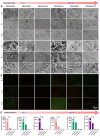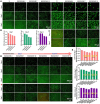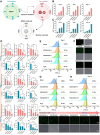Construction of EGCG/chlorhexidine functionalized coating to reinforce the soft tissue seal at transmucosal region of implants
- PMID: 40735522
- PMCID: PMC12304417
- DOI: 10.1093/rb/rbaf046
Construction of EGCG/chlorhexidine functionalized coating to reinforce the soft tissue seal at transmucosal region of implants
Abstract
Recent advancements in dental implant technology have provided more reliable and durable solutions for patients. Soft tissue seal (STS) is crucial for achieving implant stability, maintaining tissue health and promoting integration with surrounding soft and hard tissues. However, the STS around implants is fragile and susceptible to disruption by oral pathogens, particularly in patients with periodontitis or poor oral hygiene, leading to complications such as peri-implant mucositis and peri-implantitis. To promote STS formation, it is crucial to maintain the balance between bacterial and host cells while effectively managing inflammation. Although titanium-based implants exhibit biocompatibility, they lack inherent antibacterial and anti-inflammatory properties. To address these challenges, we developed a dual-function antibacterial and anti-inflammatory coating using chlorhexidine (CHX) and epigallocatechin gallate (EGCG). CHX effectively reduces bacterial adhesion but may inhibit fibroblast proliferation, while EGCG provides antioxidant and anti-inflammatory benefits. Three types of EGCG/CHX composite coatings were developed on titanium surfaces at different pH values. These coatings exhibited enhanced bacterial resistance, reduced inflammation and ROS scavenging capabilities, with higher pH levels further improving their performance. In vivo studies also confirmed that these coatings effectively prevented bacterial adhesion, mitigated inflammation and promoted STS formation, thereby holding significant promise for enhancing the long-term success of dental implants.
Keywords: STS; anti-inflammatory; antibacterial; dental implant.
© The Author(s) 2025. Published by Oxford University Press.
Figures









Similar articles
-
Interventions for replacing missing teeth: maintaining and recovering soft tissue health around dental implants.Cochrane Database Syst Rev. 2010 Aug 4;2010(8):CD003069. doi: 10.1002/14651858.CD003069.pub4. Cochrane Database Syst Rev. 2010. PMID: 20687072 Free PMC article.
-
Adjunctive antimicrobial photodynamic therapy for treating periodontal and peri-implant diseases.Cochrane Database Syst Rev. 2024 Jul 12;7(7):CD011778. doi: 10.1002/14651858.CD011778.pub2. Cochrane Database Syst Rev. 2024. PMID: 38994711 Free PMC article.
-
How surface coatings on titanium implants affect keratinized tissue: A systematic review.J Biomed Mater Res B Appl Biomater. 2022 Jul;110(7):1713-1723. doi: 10.1002/jbm.b.35025. Epub 2022 Feb 1. J Biomed Mater Res B Appl Biomater. 2022. PMID: 35103386 Free PMC article.
-
Interventions for replacing missing teeth: treatment of peri-implantitis.Cochrane Database Syst Rev. 2012 Jan 18;1(1):CD004970. doi: 10.1002/14651858.CD004970.pub5. Cochrane Database Syst Rev. 2012. PMID: 22258958 Free PMC article.
-
Interventions for replacing missing teeth: maintaining and recovering soft tissue health around dental implants.Cochrane Database Syst Rev. 2008 Jan 23;(1):CD003069. doi: 10.1002/14651858.CD003069.pub3. Cochrane Database Syst Rev. 2008. Update in: Cochrane Database Syst Rev. 2010 Aug 04;(8):CD003069. doi: 10.1002/14651858.CD003069.pub4. PMID: 18254015 Updated.
References
-
- Jiang X, Yao Y, Tang W, Han D, Zhang L, Zhao K, Wang S, Meng Y. Design of dental implants at materials level: an overview. J Biomed Mater Res A 2020;108:1634–61. - PubMed
-
- Zhou N, Dong H, Zhu Y, Liu H, Zhou N, Mou Y. Analysis of implant loss risk factors especially in maxillary molar location: a retrospective study of 6977 implants in Chinese individuals. Clin Implant Dent Relat Res 2019;21:138–44. - PubMed
LinkOut - more resources
Full Text Sources

